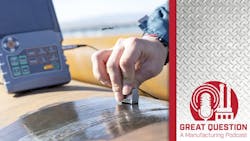Podcast: ASTM A388 explained: why 'capable of' isn’t the same as 'tested' in ultrasonic inspection
In industries where safety and precision are non-negotiable, the structural integrity of metal parts can mean the difference between flawless performance and catastrophic failure. Yet, not all quality claims are created equal. In this episode of Great Question: A Manufacturing Podcast, New Equipment Digest’s Editor-in-Chief, Laura Davis, unpacks the true meaning behind the label “capable of ASTM A388” and why it doesn’t necessarily mean a part has passed ultrasonic testing. Listeners will learn how ultrasonic inspection works, the types of hidden flaws it can reveal, and why proper surface preparation is crucial for accurate results.
This episode is based on an article originally written by Del Williams, a technical writer, on behalf of All Metals & Forge, LLC. Whether you work with forged components, oversee quality control, or just want to understand the importance of proven testing in critical applications, this conversation offers a clear, practical look at ultrasonic testing’s role in manufacturing safety and reliability.
The structural integrity of metal parts can make or break everything. And one of the best tools we have to make sure those parts are solid is ultrasonic testing, which is a non-destructive way to find hidden flaws inside metal.
But here's where things get interesting...and a little risky. You might have seen a manufacturer claim that a component is "capable of ASTM A388", which sounds official, right? But the catch is that the label doesn't actually mean the part has been tested. It just means the manufacturer believes it could pass—theoretically—if someone decided to test it. That's a big difference.
And when we're talking about equipment that's going to face high stress, extreme temperatures, or corrosive environments...that difference can mean the difference between safe operation and catastrophic failure.
For parts that aren't going to face much stress, that kind of assurance might be fine. But for critical applications—like aerospace, energy, heavy industry—we can't just take someone's word for it. Even small, invisible defects inside the metal can become serious weak points. That's why more and more OEMs are now requiring documented proof that ultrasonic testing has actually been done, not just that the part is "capable" of passing.
So, what exactly is ultrasonic testing? In simple terms, it's when high-frequency sound waves are sent into the material, and the way those waves bounce back can reveal if there are voids, cracks, or other internal issues. The ASTM A388 standard lays out how that testing is supposed to be done.
Here's the tricky part—you can't always test a forging right away. Many are delivered in what's called the "as forged" condition—basically rough, scaly, and irregular. That surface condition alone can make ultrasonic testing impossible until it's machined away.
And removing that outer layer isn't just to make the part look nice for testing—it's actually getting rid of a weak zone. During forging, that outer skin is exposed to high heat and oxidation. It can lose important elements like carbon, making it weaker and more brittle than the rest of the part. Plus, it can hide microcracks that you can't see with the naked eye. If those cracks aren’t removed, they can grow into major problems later on.
Even after that layer's gone, the surface has to be smooth enough for testing. A 500 RMS surface finish? Still too rough. You need 250 RMS so the probe can make proper contact. If it's too rough, the sound waves scatter, the signal gets weaker, and you risk missing flaws entirely.
About the Podcast
Great Question: A Manufacturing Podcast offers news and information for the people who make, store and move things and those who manage and maintain the facilities where that work gets done. Manufacturers from chemical producers to automakers to machine shops can listen for critical insights into the technologies, economic conditions and best practices that can influence how to best run facilities to reach operational excellence.
Listen to another episode and subscribe on your favorite podcast app
About the Author
Laura Davis
Laura Davis is the editor in chief of New Equipment Digest (NED), a brand part of the Manufacturing Group at Endeavor Business Media. NED covers all products, equipment, solutions, and technology related to the broad scope of manufacturing, from mops and buckets to robots and automation. Laura has been a manufacturing product writer for six years, knowledgeable about the ins and outs of the industry along with what readers are looking for when wanting to learn about the latest products on the market.
